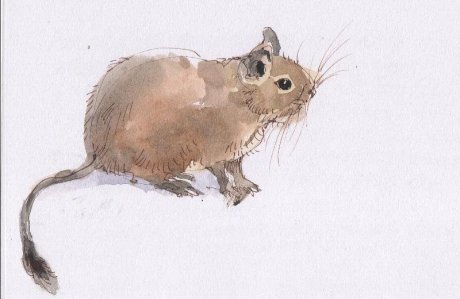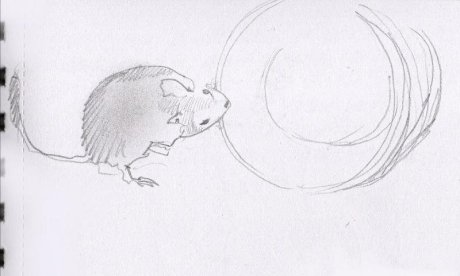This is a degu.
At first glance you might be forgiven for thinking, rat? Mouse? But then you look at the tail…. and you say to yourself, hmm, dormouse? But the size rules that out (it’s bigger than a hamster) and you realise you’re looking at something entirely different from all of these.
The first time I sketched them about a fortnight ago in their new home at Cliffe Castle all these thoughts were going through my head and I admit I was confused. In fact as I looked at their little rounded bottoms I kept thinking of guinea pigs, and just once in a while I’d suddenly see something in the eyes or the shape of a nose that made me think rabbit (though that immediately seemed ridiculous) so I kept on looking and drawing, although for a long while all my sketches looked either rat-like or guinea-pig-like – until I felt I knew what I was looking at. Degus. Very special little animals.
For sketching purposes it’s not that easy to see them clearly through the narrow link fence at the front of their enclosure (though after a while I discovered that if you crouch down until you’re on the same level as they are, you can see a lot better – perfect for children, a bit more awkward for me.) So to understand them better, when I got home I looked up some facts, googled photographs and did a couple of drawings from the screen –
– which meant that when I went back again to the animal houses a couple of days ago I had a better idea of what I’d be looking at. (I also learnt that they’re related to guinea-pigs and chinchillas and come from the high Andes, are active during the day but don’t like hotter temperatures, that they’re highly social, and that they live longer and are more intelligent than their near relatives).

Interesting facts – but I can learn a lot by watching.
So I stand with my nose pressed up against the wire, sketchbook and pen ready, and wait.
It’s a warm afternoon, and because of that they’re all inside their custom-built house which has two floors, several entrances and exits and lots of hay for bedding. I can imagine them inside all in a heap, snuggled together. (What’s the collective term for degus, I wonder?) I can just see a couple of noses, two pairs of beady eyes. They’re awake and watching me.
I don’t know if it’s getting cooler or whether they’re just curious, but one by one they start to come out of their house, sniff the air, look around. One or two of them do look at me, one from a lookout position at the top of the plank that leads to their second storey entrance, one perching on the edge of a large empty red bowl. I can see how their tails help them balance. I can see tiny toes, (I know there are five) and ears like crumpled petals.
I can see their very impressive whiskers. And the tails – with their lovely black tufted ends that I try not to exaggerate, though it’s hard not to…
Pretty soon one of them ambles slowly over to the green plastic exercise wheel, climbs in and gives it a whirl. I wonder whether I’ll be able to draw those flying feet and have serious doubts, but I give it a go anyway….. and there’s no squabbling when a second degu arrives and also wants a turn. They fit amiably side by side and go racing round together in perfect unison. I can’t draw that.
The plastic wheel is also very good for gnawing….
By now I’m beginning to feel I’ve started to get to know them, and the more I watch the more I want to touch and stroke those little rounded backs, feel the sleekness of fur, and if possible very, very gently touch a fragile ear with the tip of my finger. I can’t do that, but drawing almost does it for me; my hand may be holding a pen and touching paper, but my mind is feeling fur, whiskers, skin.








beautiful, beautiful!!! bellissimo! beautiful drawings and beautiful subject. I hope that these wonderful creatures are not in a cage…all my best! Margot
LikeLike
They are in an enclosure so large that you couldn’t call it a cage. They have lots and lots of space, and many wonderful things to climb up and burrow under and have fun with, so I think they are very well provided for – and I think that both you and Oklahoma would approve (and enjoy watching them too.) Thank you!
LikeLiked by 1 person
Dear Deborah, I’ve fallen in love with the degus!And I love your sketches of them. I should think they’ll be a great hit with the chiildren . How have you enjoyed the heat wave? All a bit too sudden. Talk sooñ. Love T ****
LikeLike
Hello! So glad you love the Degus too! I find them irresistible – and yes, they are a great attraction. Children are at the right height to get a really good view of them. But they really don’t like the heat, and the sudden hot weather must have been a bit much for them (as it was for me actually) – it’s a good thing their enclosure faces north. Lovely to hear from you though WordPress! XXX
LikeLike
These are really gorgeous! I love them.
LikeLike
Oh, Michael, thank you! I’m so glad – that means a lot to me.
I absolutely love the degus. I DON’T love all my drawings (in fact I only really like one) but that’s not the point – I just totally love drawing them.
LikeLike
They’re such lovely drawings though – so lively!
LikeLiked by 1 person
Thanks Deborah,This is really interesting, I had never heard of a degu before but I can now get the sense of them from your sketches. Hope you are well or, at least, better than when we spoke last.Sue x
LikeLiked by 1 person
Thanks! It seems most of us had not heard of degus. Delightful learning process!
LikeLike
I only know about Degus because there are some in a Zoo nearby and I fell in love the first time I saw them, soooo cute!
LikeLike
Aren’t they wonderful? The more I learn about them the more I love them. I’m so glad you’ve had the chance to get to know some too!
LikeLike